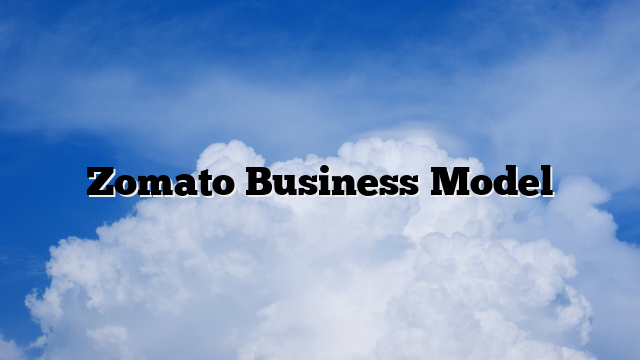Zomato Business Model

WeWork business model
February 4, 2024
Affiliate marketing vs Influencer marketing
March 11, 2024Zomato Business Model: A Multi-Course Analysis
Imagine a business model as intricate as a Michelin-starred tasting menu, with each course representing a strategic revenue stream. That’s what Zomato, the Indian foodtech giant, has concocted. So, grab your metaphorical fork and knife, because we’re about to indulge in a detailed analysis of its success secrets and future possibilities.
Table of Contents
The Appetizer: Aggregator Delight
Zomato started its journey as a simple restaurant aggregator. Hungry customers browsed menus, discovered new eateries, and made reservations, while restaurants gained wider reach. This win-win model laid the foundation for Zomato’s growth, but they didn’t stop there.
The Main Course: A Diversified Feast
The real treat lies in Zomato’s multi-pronged approach:
- Advertising Alchemy: Restaurants now pay for premium listings and targeted ads, creating an additional revenue stream for Zomato and helping eateries stand out.
- Subscription Savvy: Zomato Gold, their subscription service, unlocks exclusive discounts, priority delivery, and other perks for users, generating recurring revenue and fostering loyalty.
- Delivery Dynamo: While not their primary focus, venturing into food delivery in select cities diversifies their income and caters to the convenience-driven customer.
The Secret Ingredient: Data-Driven Decisions
But the magic doesn’t just happen in the kitchen (or rather, the app). Zomato leverages a treasure trove of user and restaurant data to:
- Personalize the User Journey: Imagine recommendations that predict your cravings or suggest restaurants based on past preferences. Data makes it possible.
- Optimize Operations: Identifying peak ordering times, popular cuisines, and high-demand areas helps Zomato streamline logistics and improve efficiency.
- Strengthen Partnerships: Analyzing restaurant performance provides data-backed insights, fostering stronger relationships with partners.
The Spice of Challenges:
No feast is perfect without a touch of spice. Zomato business model faces hurdles like:
- Cutthroat Competition: Swiggy and other players constantly innovate, keeping Zomato on its toes.
- Balancing Act: Keeping restaurants profitable while maintaining their own revenue demands careful maneuvering.
- Delivery Dilemma: Managing a large-scale delivery network requires constant optimization and cost control.
- User Fickleness: Keeping users subscribed and engaged in a competitive market requires consistent value creation.
The Dessert: A Future Full of Flavor
Despite the challenges, Zomato’s future is appetizing:
- Global Expansion: Serving international appetites could be the next big course.
- Food Ecosystem Integration: Partnering with players across the food chain, from grocery delivery to recipe platforms, could create a one-stop-shop experience.
- Foodtech Trend Investment: Cloud kitchens, vertical farming, and personalized nutrition could be the next ingredients in Zomato’s recipe for success.
Beyond the Last Bite:
Zomato’s business model is a masterclass in diversification, data utilization, and adaptation. It’s not just about delivering food; it’s about building a sustainable and scalable business in a dynamic market. So, the next time you order through Zomato, remember, it’s more than just a meal; it’s a testament to strategic innovation and a roadmap for aspiring entrepreneurs in the ever-evolving foodtech landscape.
Introduction of Zomato
Zomato, founded in 2008, is an Indian multinational restaurant aggregator and food delivery giant. It started as a simple online platform helping users discover restaurants, browse menus, and make reservations. However, it quickly evolved into a multi-faceted foodtech powerhouse, revolutionizing the way Indians dine.
Significance in the Indian Foodtech Industry:
- Market Leader: Zomato commands a dominant share of the online food delivery market in India, leaving a significant mark on the industry landscape.
- Convenience Revolution: Their user-friendly platform and extensive restaurant partnerships have made food ordering easier and more accessible than ever before.
- Economic Impact: Zomato creates numerous jobs within the delivery ecosystem and empowers restaurants by connecting them with a wider audience.
- Innovation Powerhouse: They constantly introduce new features, like Zomato Gold and cloud kitchen collaborations, pushing the boundaries of the foodtech space.
- Investor Magnet: Attracting significant investments, Zomato’s success sets a benchmark for other ventures in the Indian foodtech scene.
In short, Zomato has not only transformed the way people eat in India, but also played a crucial role in shaping and driving the entire foodtech industry forward.
Zomato Business Model: Intrigue for Investors and a Blueprint for Entrepreneurs
Beyond its delicious food deliveries, Zomato business model has captured the attention of investors and entrepreneurs alike. Here’s why:
For Investors:
- Diversified Revenue Streams: Not just a delivery platform, Zomato generates income through commissions, advertising, subscriptions (Zomato Gold), and delivery services, reducing reliance on any single source.
- Scalability Potential: As online food ordering surges in India, Zomato’s model positions it for significant growth potential in existing and new markets.
- Data-Driven Approach: The wealth of user and restaurant data allows for targeted marketing, personalized experiences, and strategic decision-making, increasing efficiency and profitability.
- Brand Recognition and Loyalty: Zomato enjoys strong brand recognition and user loyalty, providing a solid foundation for future endeavors.
- Investment in Foodtech Trends: Exploring promising areas like cloud kitchens and personalized nutrition could unlock further growth opportunities.
For Entrepreneurs:
- Multi-Model Inspiration: Zomato business model offers valuable insights for entrepreneurs seeking to create sustainable and adaptable businesses.
- Data Utilization Strategies: The effective use of data provides a roadmap for businesses to personalize experiences, optimize operations, and build strong partnerships.
- Adaptability Lessons: Zomato’s constant evolution, from aggregator to ecosystem builder, highlights the importance of adapting to changing market trends and consumer needs.
- Global Expansion Potential: The success in India suggests the model could be replicated and adapted in other markets, offering opportunities for international ventures.
- Foodtech Trend Integration: Exploring trends like delivery, vertical farming, and personalized nutrition alongside core offerings can be a source of inspiration for new business ideas.
The intrigue lies in the model’s potential to generate both financial returns and societal impact. As Zomato navigates the dynamic foodtech landscape, its journey becomes a case study for investors and entrepreneurs seeking to replicate its success or carve their own unique paths in the exciting world of food and technology.
Zomato Business Model Evolution: A Phase-by-Phase Analysis
Zomato, the Indian foodtech giant, hasn’t always been the multifaceted platform we know today. Zomato business model has gone through distinct phases, each playing a crucial role in its growth and success. Let’s delve into these phases:
Phase 1: The Aggregator (2008-2013)
- Core Offering: A simple online platform listing restaurants, menus, and contact information.
- Revenue Model: None initially, later introduced advertising from listed restaurants.
- Significance: Established Zomato as a go-to resource for discovering restaurants, building brand awareness and user base.
Phase 2: The Commission King (2013-2015)
- Core Offering: Launched online food ordering and delivery service, earning commissions on each order (15-25%).
- Revenue Model: Primarily commission-based, with increased focus on acquiring restaurant partnerships and expanding delivery reach.
- Significance: Revolutionized food ordering behavior in India, generated significant revenue, and triggered competition in the space.
Phase 3: Diversification & Data Play (2016-2019)
- Core Offering: Introduced new revenue streams like:
- Zomato Gold: A subscription service offering discounts, priority delivery, and other perks.
- Advertising Solutions: Targeted advertising options for restaurants within the platform.
- White-Labeled Delivery: Partnerships with other companies to provide delivery infrastructure.
- Revenue Model: Diversified income streams to reduce reliance on commissions, leveraged user data for personalization and targeted marketing.
- Significance: Increased customer loyalty, enhanced user experience, and established Zomato as a data-driven platform beyond just delivery.
Phase 4: Ecosystem Builder & Future Focus (2020-Present)
- Core Offering: Continued diversification with:
- Investments in foodtech trends: Cloud kitchens, hyperlocal delivery, grocery delivery partnerships.
- International expansion: Entering new markets like the UAE and Southeast Asia.
- Focus on technology & innovation: Implementing AI-powered recommendations, chatbots, and loyalty programs.
- Revenue Model: Multi-pronged approach with ongoing focus on data monetization, subscriptions, and strategic partnerships.
- Significance: Exploring new growth avenues, building a comprehensive food ecosystem, and positioning for future trends in the foodtech landscape.
Key Takeaways:
- Zomato’s business model has evolved in response to changing market needs and opportunities.
- Diversification has been key to mitigating risks and generating sustainable revenue.
- Data-driven strategies have played a crucial role in enhancing user experience and optimizing operations.
- Continuous innovation and adaptation are essential for Zomato to maintain its leadership position in the dynamic foodtech industry.
By understanding these phases, you gain valuable insights into how Zomato has built a successful and adaptable business model, offering valuable lessons for entrepreneurs and investors in the ever-evolving foodtech landscape.




